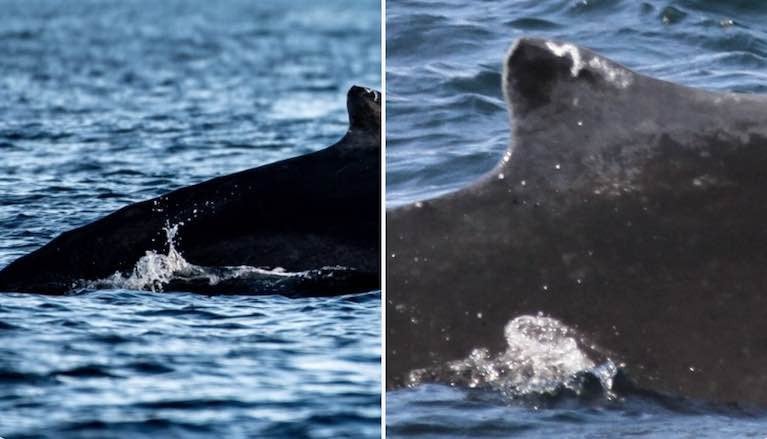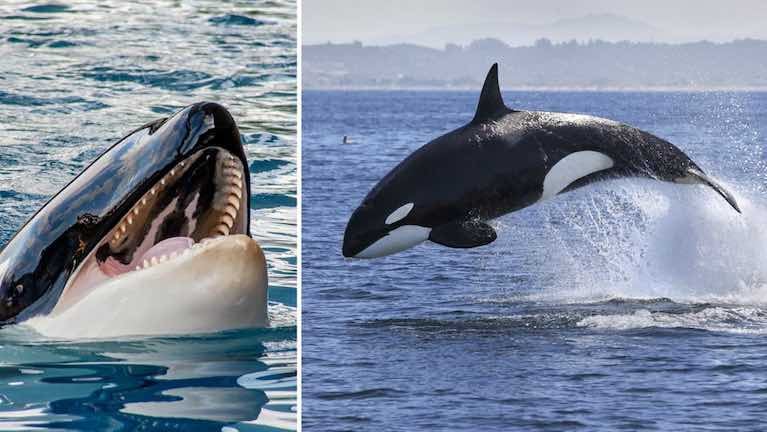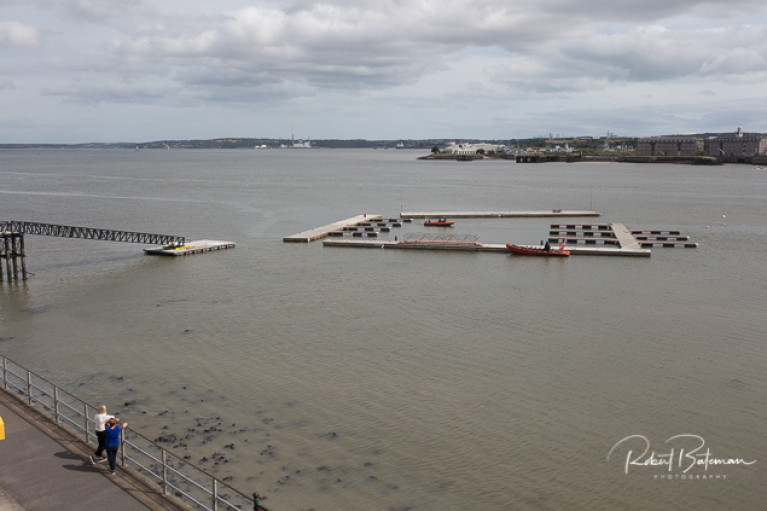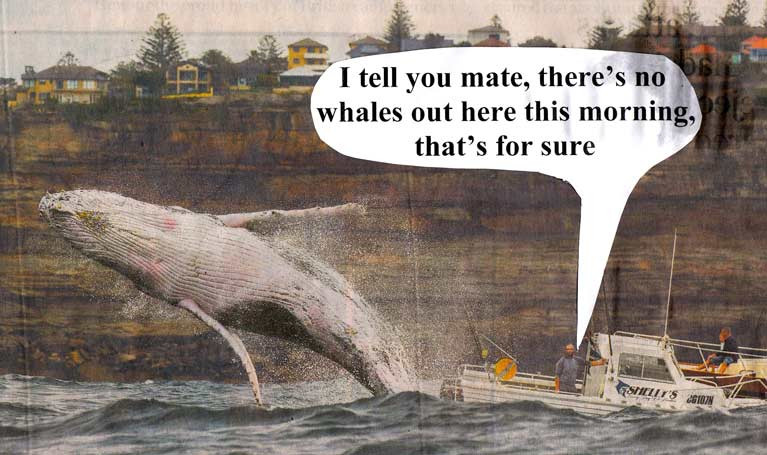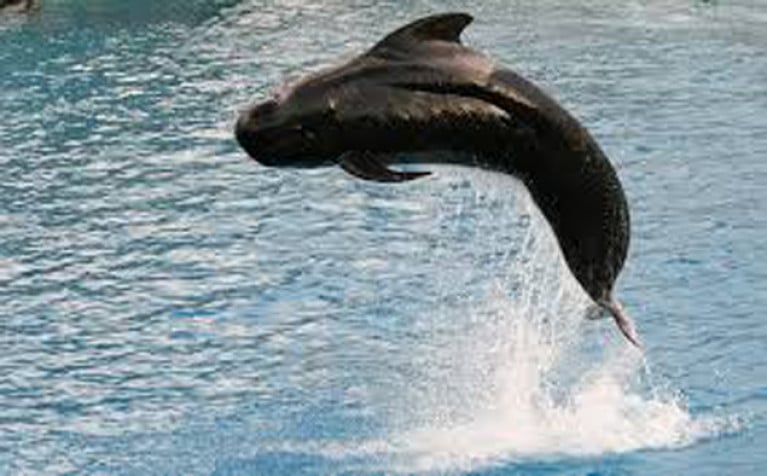Displaying items by tag: Whale
The body of a 44-foot long endangered sei whale was found on the bow of a cruise ship as it approached New York last weekend.
As CBS news reports, the carcass was discovered as the ship neared the Brooklyn Cruise Terminal.
The relevant authorities were “immediately notified,” according to the cruise ship owners, MSC Cruises.
The whale was impaled on the MSC Meraviglia, which docked at Brooklyn before sailing to ports in New England and Canada.
The carcass was taken to Sandy Hook, New Jersey for a necropsy.
The Atlantic Marine Conservation Society said that tests showed evidence of tissue trauma in the area of the whale's right shoulder blade and a fractured right flipper.
Its gastrointestinal tract was "full of food”, while samples of its organs will undergo toxicology reviews and analyses to identify any potential tissue diseases.
Robert A DiGiovanni, Atlantic Marine Conservation Society chief scientist, said it looked like the animal was alive when it was hit by the ship.
The society has responded to over 100 whale deaths in recent years, through entanglement in nets or collisions with vessels. The majority are humpback and north Atlantic whales, and a sei whale is unusual, the society said.
Sei whales are baleen whales. The filter feeders prefer deeper offshore waters.
Read the CBS News report here
The ‘spatial squeeze’ is an issue that has been coming increasingly to the fore in recent months as more concern is expressed about the pressure being exerted by offshore wind farm developers for planning approval of their proposals.
There are so many new policies being introduced to the marine environment, and so many calls for development that yet another has been highlighted by the Irish Whale and Dolphin Group.
This is Deep Sea Mining, about which it has published a review of the possible impact on whales and dolphins. It says such mining should be banned in Ireland.
Listen to the Podcast here.
 Deep Sea Mining and the possible impact on whales and dolphins
Deep Sea Mining and the possible impact on whales and dolphins
Whale Watch Day is Back
The Irish Whale and Dolphin Group has decided to hold All-Ireland Whale Watch Day again.
“We are delighted to announce the return of our popular All-Ireland Whale Watch Day,” says Padraig Whooley, Sightings Officer at IWDG. “This event comprises free and guided whale watches at local headlands and vantage points and will be held on Saturday, August 20, from 2-4 p.m.
This year’s event is timed to coincide with Heritage Week in Ireland. These simultaneous land-based watches at 18 locations around the Irish coast provide IWDG researchers with a unique overview of cetacean (whales and dolphins) and basking shark activity on the day.
“It is suitable for all ages and aimed at everyone from the novice wildlife enthusiast to more experienced naturalist with an interest in biological recording. For the public, as Citizen Scientists, you can also play an important part,” says Whooley. “While there are no guarantees of sightings, given reasonable weather you have a good chance of seeing some of the varied marine species that can be viewed locally.”
Details and updates here
Irish Researchers Contribute to Identifying New Whale Species
Irish whale experts have contributed to the identification of a new species of whale which is so deep diving that it has rarely been recorded before.
A global network of researchers including Prof Emer Rogan of University College Cork/Environmental Research Institute used sophisticated genetic analysis to confirm the identification.
The new type of whale, which was washed up on the New Zealand coast almost a decade ago, is believed to be one of about 1.5 million as yet undiscovered species in the deep ocean.
It has been named Ramari’s beaked whale after Ramari Stewart, a Mātauranga Māori whale expert, while its scientific name, Mesoplodon eueu, refers to its indigenous roots in South Africa.
 The new whale species, Ramari's beaked whale, which Irish researchers helped to identify
The new whale species, Ramari's beaked whale, which Irish researchers helped to identify
Prof Rogan says the identification is exciting on two fronts – the first being confirmation of any new species of marine mammal, and the second being that this particular whale has been given an indigenous name to acknowledge the Maori input in the research.
As Prof Rogan explained, it was originally believed that the mammal washed ashore on the west coast of Te Waipounamu (South Island), Aotearoa New Zealand was a True’s beaked whale.
Named An Míol mór socach breá in Irish, the True’s beaked whale was named after Frederick True, a curator at what is now the US Smithsonian, and some 14 of this type have been recorded on the Irish west coast.
The squid-eating whale has never been hunted, and most knowledge of it comes from stranding records as it can dive thousands of metres to find its prey and spends a lot of time offshore.
However, Ramari Stewart knew there was something different about this whale and contacted biologist Dr Emma Carroll of the University of Auckland.
Prof Rogan and colleagues including Dr Simon Berrow of the Irish Whale and Dolphin Group (IWDG) and Galway-Mayo Institute of Technology were then among a number of researchers asked to provide samples.
“When it was confirmed that this was not a True’s beaked whale, we did establish that it was closely related and may have been separated around two million years ago,”Prof Rogan says.
The discovery brings the total number of beaked whale species to 24, with this new one being indigenous to the southern hemisphere.
“It’s wonderful that a new míol mór species has been discovered and highlights just how little we know about biodiversity in the deep sea,”Prof Rogan said.
“ Deep diving beaked whale species are difficult to study,” she said.
“The work involved a large collaboration of researchers and indigenous practitioners across the globe with the multi-discliplinary nature of the work demonstrating the importance and value of long term cetacean stranding programmes and data collection, along with museum and tissue archives,”she said.
Naming it after Ramari Stewart is also “a fitting tribute to an amazing woman, practised in traditional skills and knowledge, while also highlighting the disappearance of many local languages”, Prof Rogan added.
Dr Emma Carroll and collaborators have published the findings in the international journal Proceedings of the Royal Society.
More here
The Bigger The Whale, The Friendlier They Are (Video)
There have been many reports of orcas - aka “killer whales” - attacking boats off the coast of Portugal and Spain. But large and all as they are, orcas are among the smaller whale species. And it seems that the bigger the whale, the more confident and friendly they are.
This drone video shows first one and then a pair of southern right whales interacting in the most harmless possible way with a very cool paddle boarder for an extraordinary inter-species experience. But as with everything to do with humans and whales, there’s a twist to the tale.
The “right whale” is so named because if you were on a whaling expedition, this was the right whale to hunt and slaughter for optimal profitability. Despite that, the sub-species has survived, and numbers are now back at healthy level.
First Irish & Scottish Humpback 'Match' Made By Irish Whale & Dolphin Group
The first Irish and Scottish Humpback 'match' has been made from images taken on the Shetland Islands at the weekend and then matched to photographs of the same whale off Ireland in 2015 and seen again off Irish coastal waters as recently as June 2020.
In an exciting development for Irish marine wildlife fans, the Irish Whale and Dolphin Group (IWDG) confirmed on social media this morning (see below) that the Irish Humpback whale named #HBIRL38 was photographed on 7 November off Whalsay, Shetland. This whale has been recorded 16 times by the IWDG over four years since July 2015 and was last seen off West Cork on 2 June 2020.
First humpback match between Ireland and Scotland.
— Irish Whale and Dolphin Group (@IWDGnews) November 11, 2020
Irish Humpback whale #HBIRL38 was photographed on 7 November by Ryan Leith off Whalsay, Shetland. This individual has been recorded 16 times by the IWDG over 4 years since July 2015 and was last seen off West Cork on 2 June 2020 pic.twitter.com/3JU2GgwYPn
First Irish ??Scottish ??????? Humpback 'match' from images taken here in #Shetland on Saturday by @DraatsiInk and me on Sunday 35km to the south. Nick Massett of @IWDGnews matched pics to an individual photographed off southern Ireland in 2015 and seen there as recently as June 2020. pic.twitter.com/M2asY8e26g
— Hugh Harrop Wildlife (@HughHarrop) November 10, 2020
Mystery of Orca Whale Attacks on Boats Continues off Spanish Coast
Stories of whales attacking boats at sea and sometimes sinking them go back a long way in maritime history, and as often as not it has happened in such a sudden and frightening way that identifying the precise species has not been part of the narrative.
But since mid-September, an increasing number of reports of whale attacks off the coast of Spain and Portugal have identified the largest dolphin, the orca or "killer whale", as being responsible for a continuing spate of attacks. And with verified incidents of rudders being torn off and hulls and keels - usually of fibreglass sailing boats – being seriously damaged, the maritime authorities in northwest Spain have become so concerned that a quite extensive exclusion zone for smaller craft has been imposed off the rugged coastline between El Ferrol and Punta de Estacia de Bares.
 The exclusion zone for smaller craft off the rugged coastline between El Ferrol and Punta de Estacia de Bares
The exclusion zone for smaller craft off the rugged coastline between El Ferrol and Punta de Estacia de Bares
Several theories have been put forward to explain the unusually high incidence of these events, and in response to sensationalist local headlines of "TERROR KILLER WHALE ATTACKS", noted ocean voyager and marine scientist Vera Quinlan of Galway has made the reasonable point that it is humans invading their space who have described them as "killer" whales. They are in fact the largest species of dolphins, and it takes some of the heat out of the situation to give them their proper name of orca.
Nevertheless, the danger can ultimately be very real, and theories abound, such as the behaviour being a hostile response by whales to the sudden and marked increase in engine and propellor noise after some limitations of the pandemic lockdown was lifted in Spain, with coastal leisure traffic increasing to end a period of peace which was akin to the welcome silence which until recently prevailed onshore around noisy airports.
But as to whether or not it's an inbuilt whale dislike of fibreglass is difficult to assess, as the vast majority of boats have long since been constructed in GRP.
It's also said that modern hull shapes with the keel separate from the rudder may seem to whales like some sort of threatening sea creature, while another notion is that the whales approach the boat with very friendly or indeed amorous intentions, and then take a whack at it on being found they were mistaken.
As for keeping the engine running, the fact is a number of the attacks have taken place on boats which were motor-sailing.
And finally, there are those who reckon that the colour of your underwater paint is a significant factor. Old salts will tell you that having a white or red under-body is just asking for trouble – dark blue or black anti-fouling is your only man if you want to stay onside with the ocean cousins.
Tough Time for Cork Sailing But Best Known Whale Loves Cork Waters
Sailing in Cork took a hammering in the past week, from Storm Ellen and COVID 19, the combined effects of which destroyed a lot of work by four of the major clubs on the South Coast.
Disheartening for the sport and for club members who voluntarily put many hours of work into keeping within Government guidelines while preserving major events in the sailing calendar, but all of which effort came to naught.
Sailing Event Cancellations
Two Cork Harbour clubs, the Royal Cork Yacht Club at Crosshaven and Monkstown Bay Sailing Club, with the support of Cork Port at its new leisure boat launching facility at Ringaskiddy, made late changes to running the Laser Nationals, which were brought to an end when the Government imposed further restrictions. Those also stopped the RCYC Tricentenary Parade salute to the club's history and its planned 'At Home' this coming weekend. The RCYC had already suffered several wipe-outs of its 300th celebration plans that will now take place in 2021.
That was followed by the cancellation of Dragon Week at Kinsale which had been arranged to replace the previously cancelled international Gold Cup.
 The village of Crosshaven in Cork Harbour where so many plans to celebrate Royal Cork's 300th birthday have been postponed unttil 2021. Photo: Bob Bateman
The village of Crosshaven in Cork Harbour where so many plans to celebrate Royal Cork's 300th birthday have been postponed unttil 2021. Photo: Bob Bateman
Diligent Sailing Clubs
The three clubs stayed diligently within new Government restrictions though my question to Government about the contradiction in allowing more people to congregate internally than at outdoor events, a contradiction which challenges the benefits of sport and outdoor activity, goes unanswered so far. The anger expressed privately when the Golfgate scandal was revealed, was considerable and justified, in my view.
Added to this was the situation for Cove Sailing Club, hit hard by Storm Ellen causing considerable damage to its recently-opened marina.
West Cork Whale 'Boomerang'
A bad week for sailing on the South coast, so I was looking for something to lift spirits, which came when the best-known whale in Irish waters was discovered back in West Cork. This is Boomerang, pictured here in a stunning photograph by Ronan McLaughlin, provided by courtesy of the Irish Whale and Dolphin Group.
 Boomerang is back in Irish waters Photo: Ronan McLaughlin, courtesy IWDG
Boomerang is back in Irish waters Photo: Ronan McLaughlin, courtesy IWDG
Boomerang likes the waters of Cork and Waterford, but seemingly not Kerry! Identified by the Irish Whale and Dolphin Group, he is an adult male humpback whale, first seen off the West Cork coast nineteen years ago this month - in August of 2001.
"He is by far the best-known whale in Irish waters and his annual return most years to our local waters, is the strongest evidence we have of the importance of our inshore waters for these gentle giants," Padraig Whooley, Sightings Officer of IWDG reported on my radio programme, THIS ISLAND NATION. "Interestingly," Padraig said, "Boomerang, despite over 53 sightings in almost 20 years has never once been recorded in Kerry, only Cork and Waterford."
Maybe, I wonder, he doesn't want to challenge Fungi in Dingle?
Padraig Whooley of IWDG has more about Boomerang on the Podcast below
Australian Pro Whalewatcher has Bad Day at the Office
As seen off Sydney on Wednesday, as whale-watching is resumed after ending of COVID-19 Lockdown.
You know how it is? Sometimes, for one second, you’re just looking the wrong way altogether.
Was West Cork’s Tame Pilot Whale Ahead of his Time?
Whales, dolphins and porpoises hold a very special place in people’s hearts and minds. It may be a very long time since our shared mammalian ancestors went their respective ways, but when we get anywhere near “the cousins” in their watery world, there’s a special feeling. Particularly so when the individual involved is Fungi the bottlenose dolphin of Dingle, with his hopes for appreciative human company being stymied for now by the pandemic restrictions, even as his usual sociable season with its requirement for an appreciative audience moves towards its midsummer heights.
Those of us who have a gut feeling that the Covid-19 is going to be gone from Ireland like snow off a ditch by the end of May, well, we keep our notions to ourselves out of respect for the continuing heroic struggle of the frontline workers, and the specialists and those who provide them with management backup. And yes, we do accept that there’s a fair chance that it will return as autumn’s damp and cold and gloom descends on us. But in the meantime, there’s going to be a summertime window of opportunity, and we’ll all go mad if we don’t use it.
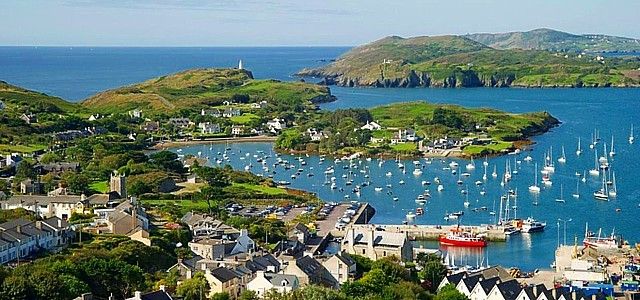 The Cove in Baltimore, where the pilot whale Albert was still an occasional presence in his final days in 1968
The Cove in Baltimore, where the pilot whale Albert was still an occasional presence in his final days in 1968
Meanwhile, the story of Fungi’s frustration here on Afloat.ie last week was clicking vigorously, as was Betty Armstrong’s subsequent story about a pod of orca whales in Strangford Lough. But there was an added dimension to the Fungi yarn, with our query as to whether anyone remembered Albert, the dolphin or pilot whale who used to make his home in and around Baltimore, and was into occasional interaction with moored cruising yachts. He reputedly enjoying the trick of gathering up the cruising folk’s ground tackle as they lay anchored for the night off Baltimore, and leaving them such that they woke up to find themselves anchored off Sherkin.
It was a memory which hit the spot among Afloat.ie viewers. Bells rang out, and pensioners danced in the streets - or more accurately, they leapt to their Smartphones and iPads, and we soon had enough facts and figures to form an Albert the Pilot Whale of Baltimore Club.
Brian Marten, well known for his work in the local community in West Cork and also for commissioning the re-birth of the 1893 Baltimore-built gaff cutter Eva as Guillemot by Liam Hegarty at Oldcourt, is right there with chapter and verse:
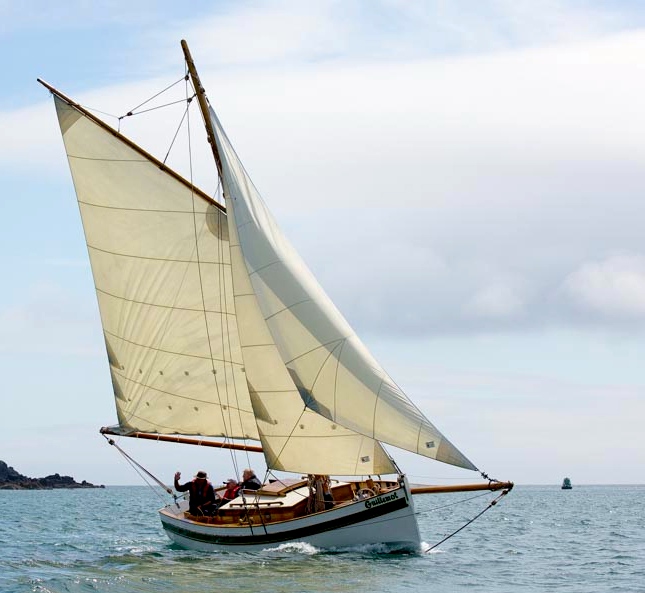 Spirit of Baltimore: Brian Marten’s Guillemot – originally built as Eva in Baltimore in 1893 – is another successful Liam Hegarty restoration. Photo: Robbie Murphy
Spirit of Baltimore: Brian Marten’s Guillemot – originally built as Eva in Baltimore in 1893 – is another successful Liam Hegarty restoration. Photo: Robbie Murphy
“Sailing around Baltimore as a schoolboy, encounters with Albert were very common - he liked to hang around the Catalogues, (between Sherkin and Heir Island, west of Turk Head, I'm sure you know them). I often saw him jump clear out of the water one or more times in that channel. I recall seeing him jump out of the water near Sherkin when I was very small, one of my earliest memories. I believe that he disappeared some time in the late 1960's, probably died of old age. I don't think a carcass was ever reported.
He most definitely was not a dolphin, being much larger, probably at least 15ft to 18ft long as I recall. I usually saw him while in my brother Alan's National 18 (Alan Marten is currently co-owner of the classic River Class sloop Gweebarra in Strangford Lough, where he is a former Commodore of Strangford Lough YC).
People said Albert was a Pilot Whale, as you mention, but that may have been hearsay. There must have marine biologists around at the time who knew exactly what type he was. I say "he", as he was always referred to as masculine. Anyway, he never had babies, though to be fair that would have required two of the species.
We would usually hear him blowing in the harbour on a quiet night while walking back to the Cove from Dinny Salter’s (now Bushe’s).”
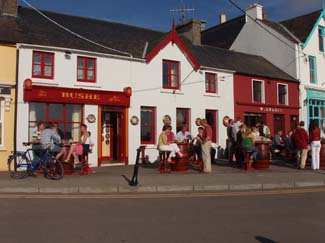 West Cork oasis – Bushe’s of Baltimore was still Dinny Salter’s when Albert the Pilot Whale was part of the local scene
West Cork oasis – Bushe’s of Baltimore was still Dinny Salter’s when Albert the Pilot Whale was part of the local scene
The proper slaking of thirsts in Baltimore was always a sensible priority, but right now the thirst is of the boats and their timberwork, and the challenge down there is to get the local fleet of traditional and classic wooden boats afloat as soon as possible after the Lockdown paralysis, which in recent weeks had been subjecting them ashore to excessive temperatures (both high and low) and searing sunshine
But as to Albert, it seems he was a Pilot Whale, and Brian’s estimate of a length of 15ft to 18ft (5.5 metres) hits the spot, whereas a bottlenose dolphin barely gets to 4 metres, though I’d say Fungi is all of that. Certainly, it means that if he were of a hostile nature, he could be a real menace, and a couple of years ago attempts to befriend and swim with a bottlenose dolphin at Doolin in County Clare went astray, with people being injured.
As for the leaping from the water, that seems to be both sheer exuberance, and the need to shake off sea lice. When a creature the size of Albert did it within the confines of Baltimore Harbour, it was quite something, but occasionally basking sharks do the same, and in recent years that inveterate ocean observer Youen Jacob of Baltimore has recorded basking sharks in the neighbourhood making their leap for freedom.
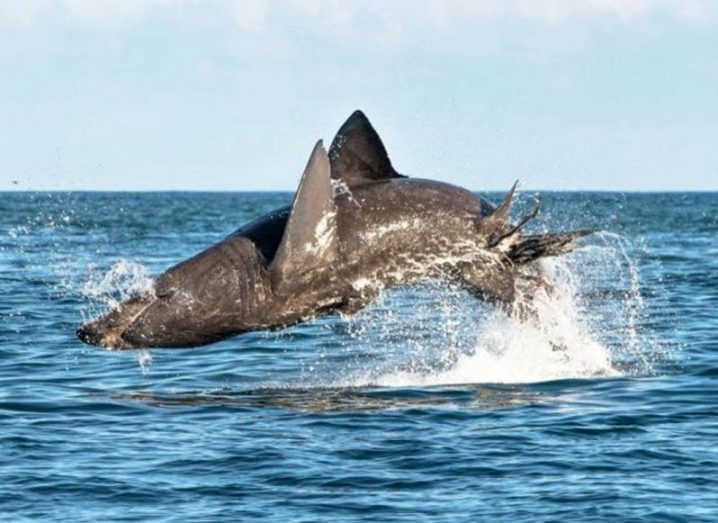 He’s kind of all over the place, but at least he’s doing it – the rare sight of a basking shark jumping, as recorded by Youen Jacob of Baltimore. Photo: Youen Jacob
He’s kind of all over the place, but at least he’s doing it – the rare sight of a basking shark jumping, as recorded by Youen Jacob of Baltimore. Photo: Youen Jacob
Back in 1961 when I was cruising solo in a 23-footer off the west coast of Scotland, the word was out that basking sharks were a-leaping at the north end of Kilbrannan Sound between Arran and Kintyre. This was interesting – in the Chinese Mandarins’ interpretation of the word – as I wanted to sail up the Sound from Campbeltown to Tarbert, and sure enough off northwest Arran, there were some mighty splashes around. We – the little boat and me – were sailing along holding to the Kintyre shore thinking we were safe enough, when some eccentric biggie decided that this was exactly where he wanted to let his sea lice get off.
It seemed to me he jumped much more than the 1.2 metres which is all that basking sharks are supposed to achieve, suggesting he might have been a pilot whale. But either way, he was much too close for comfort, and I wasn’t in a species-identifying frame of mind, being just mighty glad there was only the one performance.
That night in the pub in Tarbert, the barman relished telling me that some years previously, there’d been another spate of shark-jumping in the same area. A boat only slightly larger than mine was sitting becalmed off Loch Ranza on the Arran shore, with two crew on board, when a very large basking shark or pilot whale shot blindly upwards out of the water and landed plumb on top of them, leaving only matchwood, with the bodies never found.
So maybe back in the 1930s, 40s, 50s and 60s when Albert was making the scene around Baltimore, it was common sense to accept that he was big enough to be accidentally dangerous, and anyway any notion of making him into a tourist attraction would generally have been out of kilter with the rather solemn mood of the time.
But his memory still evokes other memories, and former Baltimore Sailing Club Commodore Gerald O’Flynn wrote:
“Regarding your article on Fungi, you made reference to Albert who resided in Baltimore Harbour and its environs for many years. The late Tom Fuller, who was the founder of Baltimore Sailing Club in 1956, often told the story of Albert. He first became aware of Albert in the early '30s, and around that time he was asked by some local fishermen to "take care of that bastard!”
But Tom always thought he was an addition to the harbour, and always liked to be told when and where we saw him. Albert was a constant presence in the 50s and 60s, when he would suddenly loom up alongside, which was quite intimidating when aboard a National 12 dinghy.
My brother Dom was the last of our family to experience him - that was when he lived in the Cove around 1968. In bad weather, he said, you could hear Albert snorting away in the sheltered Cove at night. Personally, I didn’t see or hear him after the early 60's. We always thought that he was bigger than a dolphin, but that might have been because he didn’t seem to have a dolphin’s beaked nose – it was definitely a rounded one.
I’ve been a member of the Baltimore SC since its foundation in 1956, and was Commodore in 84/85. I remember meeting you on a few occasions - one in particular with the late Hugh Kennedy, when you’d sailed in to Baltimore on a cruise to the West Cork Regatttas, and we attempted to put the world to rights one sunny afternoon.”
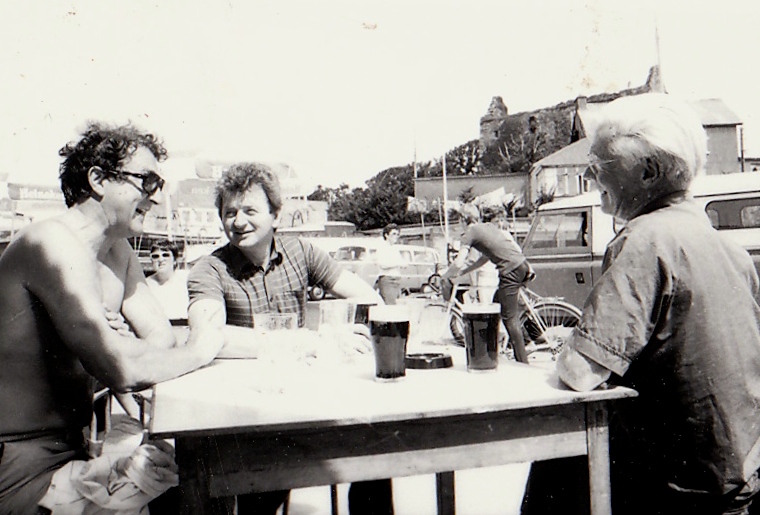 Putting the world to rights – Baltimore in the summer of 1984, with (left to right) Hugh Kennedy, Dom O’Flynn, Brendan Cassidy, and beyond him the castle, without its roof in those distant days. Photo: W M Nixon
Putting the world to rights – Baltimore in the summer of 1984, with (left to right) Hugh Kennedy, Dom O’Flynn, Brendan Cassidy, and beyond him the castle, without its roof in those distant days. Photo: W M Nixon
Memories, memories. Tom Fuller was indeed a lovely man, with vision ahead of his time. Thanks to Ger O’Flynn, we now know that way back in the 1930s, there was at least one person in Baltimore who appreciated that there was potentially much more to Albert than a nuisance who consumed vast quantities of fish.
As for that remembered gathering in the sunshine in Baltimore, it was 1984, and we were in West Cork with our visit built around the Centenary of Schull Regatta which was in the midst of the West Cork Regattas when they were in more traditional form. Thus Ger and his late brother Dom (who also served as a BSC Commodore) were in the throes of preparation for Baltimore Regatta on the Bank Holiday Monday, but “urgency” acquires a more relaxed meaning in summertime in Baltimore, and though Ger had nipped away to sort some little problems when I took the photo of Hugh Kennedy, Dom O’Flynn and Brendan Cassidy of Howth undoubtedly putting the world to rights in the sunshine, everything took place as expected.
It was something of a miracle we were there at all, as mid-July bad seen us handling the Press Office at ISORA Week, then we’d set off with our little Hustler 30 Turtle for an ambitious cruise taking in southwest Wales including inveigling our way ashore on the monastic island of Caldey, a night at Lundy in the midst of the Bristol Channel, round Land’s End for a few days in Falmouth where the family were on holiday, a proper little visit to the Isles of Scilly, and then nor’west to West Cork and suddenly there we were, on the quay in Baltimore, and a full plenary session in place.
Even at Schull Centenary Regatta when the wind failed completely, it was no problem - they decided that Michael O’Leary of Dun Laoghaire with the Holland 39 classic Imp had clearly been shaping up to be the winner, so they simply moved the finishing line out to the completely becalmed Imp by dropping the outer mark on one side of Imp, then taking the committee boat round to the other, and then firing the gun to make him line honours and corrected time winner.
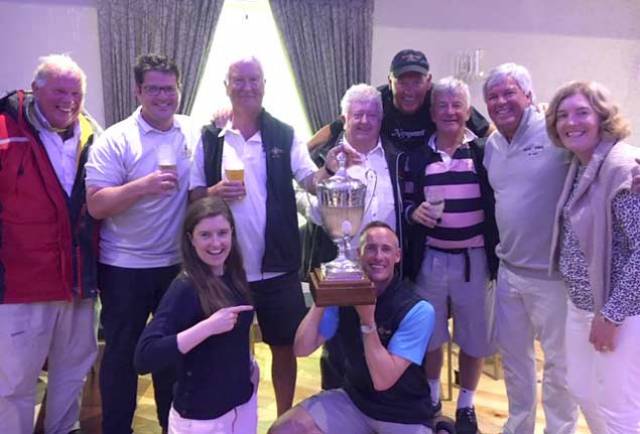 Still at it. Michael O’Leary (centre) in the midst of his shipmates after winning overall with the Dufour 44 Act Two in the 2019 Calves Week White Sails Division, thirty-five years after winning the Schull Centenary Regatta at the same venue with Imp
Still at it. Michael O’Leary (centre) in the midst of his shipmates after winning overall with the Dufour 44 Act Two in the 2019 Calves Week White Sails Division, thirty-five years after winning the Schull Centenary Regatta at the same venue with Imp
There were memories of all this last year when the same Michael O’Leary and partners were the White Sail overall winners at Calves Week in Schull with the Dufour 44 Act Two, but for me the sweetest memories of 1984 are of Cape Clear Regatta, which was organised by the late Derek Harte and his many friends with their “Cape Clear Advanced Regatta Computer”.
To everyone else, the Computer looked like a cardboard box with a tape coming out of it, with a long row of adhesive labels on the tape, each with the name of one of the entered boats. All of us got a prize of an attractive piece of locally-fired pottery. But as Teddy Crosbie had sailed a blinder with his Sadler 32, he rightly got the Pope Cup for the overall winner, and all was well with the world.
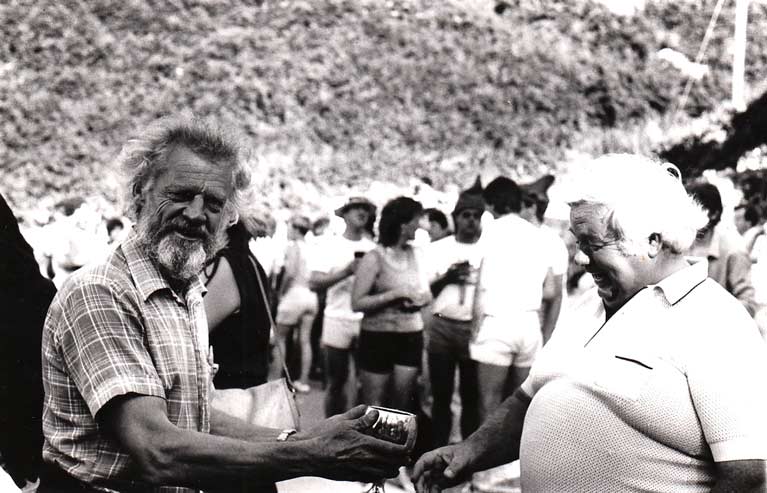 Derek Harte (left) presents Teddy Crosby with the Pope Cup for overall champion, Cape Clear Regatta 1984. Photo: W M Nixon
Derek Harte (left) presents Teddy Crosby with the Pope Cup for overall champion, Cape Clear Regatta 1984. Photo: W M Nixon
And if we have strayed more than somewhat from whether or not, once upon a time, there was a creature of significance in the seas around Baltimore called Albert, and whether or not he was a dolphin or a pilot whale or whatever, well so be it, that’s the way it is with West Cork.


























